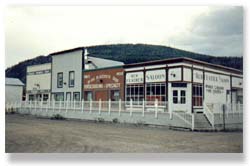
We loved Dawson City! It wasn't nearly as touristy as all of the
California Gold Rush towns that we had driven through. Dawson still
looks pretty much the same. We found an excellent campground across
the river and we had to take the small ferry across each time we
went into town.

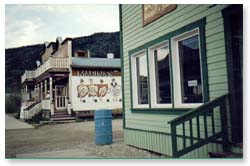
If you are going to Dawson City, you have to stop in to see Diamond
Lil and her CanCan dancers.

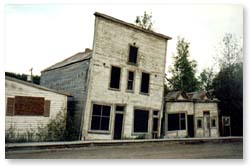
These leaning buildings are a result of permafrost - perennially
frozen ground. Vast tracts of permafrost lie across Canada, Alaska,
northern Europe and Asia, and Antarctica.

A history lesson. A century ago, Dawson City was a gold rush boomtown.
Today the community of Dawson City is still a gold mining center.
However, the main economic activity is tourism, based on the community's
colorful past and historical importance. Dawson is located about
536 kilometers northwest of Whitehorse, at the end of the Klondike
Highway.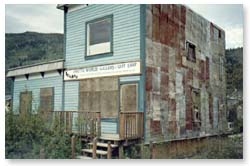 The town of Dawson City lies within the traditional lands of the
Han people, the Tr'ondek Hwech'in First Nation. The Han used the
site where the town now stands, at the confluence of the Yukon and
Klondike rivers, as a seasonal fishing camp. The discovery of gold
in the Klondike valley in 1896 led to the establishment of a tiny
community where the Klondike flows into the Yukon. By the summer
of 1898 Dawson City was the largest city in Canada west of Winnipeg,
with a population of 40,000 in the immediate area. Within months,
Dawson boasted telephones, running water, steam heat, steamboat
services, and a wide range of elaborate hotels, theatres, and dance
halls. A year later the Gold Rush was over and 8,000 people left
town in a single summer. By 1902 Dawson City's population had dropped
to 5,000, declining further in the early part of this century. In
the early 1960s Dawson City was declared a National Historic Site.
Preservation of buildings and historic areas, an assortment of activities
related to the Klondike Gold Rush, and other tourism initiatives,
draw some 60,000 visitors each year.
The town of Dawson City lies within the traditional lands of the
Han people, the Tr'ondek Hwech'in First Nation. The Han used the
site where the town now stands, at the confluence of the Yukon and
Klondike rivers, as a seasonal fishing camp. The discovery of gold
in the Klondike valley in 1896 led to the establishment of a tiny
community where the Klondike flows into the Yukon. By the summer
of 1898 Dawson City was the largest city in Canada west of Winnipeg,
with a population of 40,000 in the immediate area. Within months,
Dawson boasted telephones, running water, steam heat, steamboat
services, and a wide range of elaborate hotels, theatres, and dance
halls. A year later the Gold Rush was over and 8,000 people left
town in a single summer. By 1902 Dawson City's population had dropped
to 5,000, declining further in the early part of this century. In
the early 1960s Dawson City was declared a National Historic Site.
Preservation of buildings and historic areas, an assortment of activities
related to the Klondike Gold Rush, and other tourism initiatives,
draw some 60,000 visitors each year.

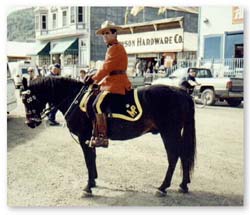
The Royal Canadian Mounties - still on duty.

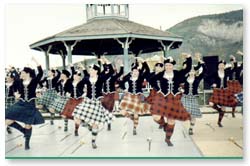
We were lucky to be in Dawson for their July holiday which is much
like our Fourth of July. The whole town came out for picnics while
the dancers entertained on the banks of the river.

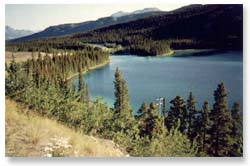
Leaving
Dawson City, we started back to Whitehorse and took the Klondike
Highway to Skagway. This scenic highway is a feast for the eyes
and the camera. There is a train ride that you can also take via
this route.

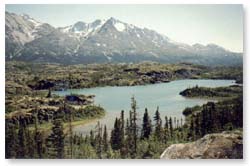
The lake water here is not crystal clear because of the silt.

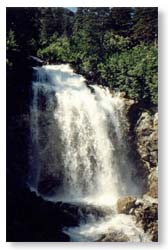
We were welcomed by this beautiful waterfall, right before entering
Skagway.

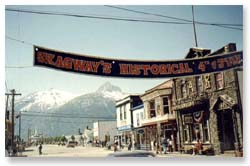
We arrived in Skagway in time to celebrate our 4th of July holiday.
If you look real close - you can see a cruise ship at the end of
the block. Most all of the cruise ships stop here. Out of all of
the small towns we visited - Skagway was the most friendly to tourists.
As usual we had no reservations - and arrival on the 4th of July.
But, the natives were friendly and found us a place to pitch our
tent for a few days.

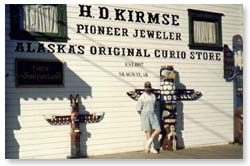
We had to take at least one picture of the Totem Poles. Notice the
one wearing the blue shorts. How come I'm not in any of these pictures
- I'm the one holding the camera..

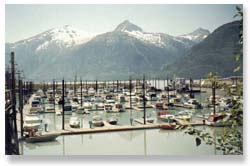
This is the marina at Skagway and where the cruise ships come in.
The photo looks foggy, but it was a misty day. The water here is
also filled with silt.

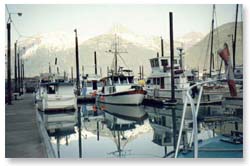
This was the 4th of July and later in the day we saw the fireworks
display over this scene. We saw the reflection of the fireworks,
along with the mountains and boats, in the water. Unfortunately,
my camera is not good enough to take evening pictures. So you only
get to see the day shot.

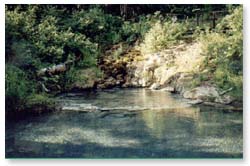
We really
hated to leave Skagway, but our feet were itching to find out what
was further down the road. We stopped a few times take a dip in
the hot springs we found along the way. This place actually had
to pipe cold water into the springs, because the water that came
up out of the ground was boiling!!

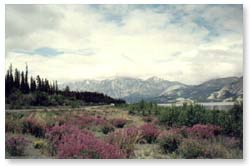
We said good-bye to Alaska and the Yukon and raced along the highway
to the Canadian Rockies.






 The town of Dawson City lies within the traditional lands of the
Han people, the Tr'ondek Hwech'in First Nation. The Han used the
site where the town now stands, at the confluence of the Yukon and
Klondike rivers, as a seasonal fishing camp. The discovery of gold
in the Klondike valley in 1896 led to the establishment of a tiny
community where the Klondike flows into the Yukon. By the summer
of 1898 Dawson City was the largest city in Canada west of Winnipeg,
with a population of 40,000 in the immediate area. Within months,
Dawson boasted telephones, running water, steam heat, steamboat
services, and a wide range of elaborate hotels, theatres, and dance
halls. A year later the Gold Rush was over and 8,000 people left
town in a single summer. By 1902 Dawson City's population had dropped
to 5,000, declining further in the early part of this century. In
the early 1960s Dawson City was declared a National Historic Site.
Preservation of buildings and historic areas, an assortment of activities
related to the Klondike Gold Rush, and other tourism initiatives,
draw some 60,000 visitors each year.
The town of Dawson City lies within the traditional lands of the
Han people, the Tr'ondek Hwech'in First Nation. The Han used the
site where the town now stands, at the confluence of the Yukon and
Klondike rivers, as a seasonal fishing camp. The discovery of gold
in the Klondike valley in 1896 led to the establishment of a tiny
community where the Klondike flows into the Yukon. By the summer
of 1898 Dawson City was the largest city in Canada west of Winnipeg,
with a population of 40,000 in the immediate area. Within months,
Dawson boasted telephones, running water, steam heat, steamboat
services, and a wide range of elaborate hotels, theatres, and dance
halls. A year later the Gold Rush was over and 8,000 people left
town in a single summer. By 1902 Dawson City's population had dropped
to 5,000, declining further in the early part of this century. In
the early 1960s Dawson City was declared a National Historic Site.
Preservation of buildings and historic areas, an assortment of activities
related to the Klondike Gold Rush, and other tourism initiatives,
draw some 60,000 visitors each year. 









